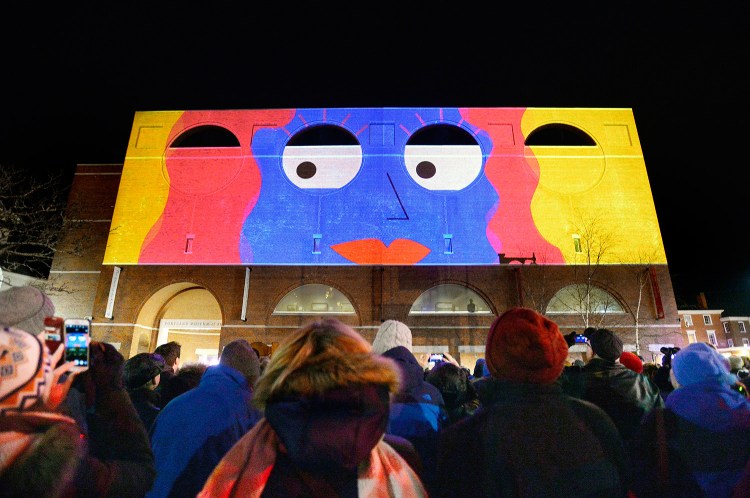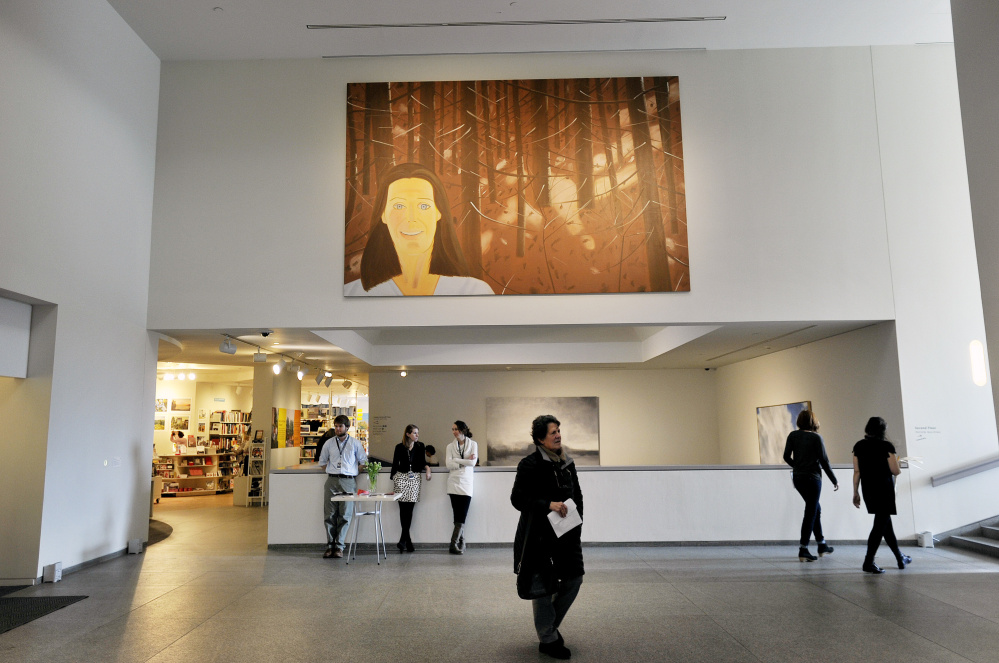The Portland Museum of Art reopens Friday after being closed a month for another round of fixes, improvements and the reinstallation of art throughout the galleries. The reopening will create a public stir and interrupt traffic around the museum Friday evening.
The updated museum will open during First Friday Art Walk, after a large-scale animated 3D movie, “Lights Across Congress,” on the museum’s exterior facade facing Congress Street. Free Street will be closed from Congress to Oak streets from 5 to 9 p.m., said Jessica Grondin, director of communications for the city. Congress Square across from the museum will host a mini-carnival with ice sculptures, food trucks and entertainment to create a block party atmosphere.
The projection begins at 6:30 p.m. and lasts about six minutes. “If you arrive at 6:34, you will miss most of it,” said Graeme Kennedy, director of public relations. “We’re telling people to plan to be at the museum around 6:15.”
When the projection ends, the museum will reopen – for free. Friday nights are free at the museum, but it also will waive admission on Saturday to encourage people to come see the changes. “We’re happy to be reopen, and we want people to come celebrate with us,” said Mark Bessire, museum director.
The changes are part of a multi-year, $2.7 million improvement project dubbed “Your Museum, Reimagined.” This is the second year the museum has closed for all or much of the month of January, to allow staff members and contractors to tackle renovations more efficiently when the building is empty of visitors. The most visible change is in the Great Hall, where visitors enter the museum on Congress Square. The admission desk, which had previously jutted out from a wall, has been recessed into that wall, allowing a larger public gathering space. The semi-permanent wall-painting of colorful cubes by Mark Wethli, “Transom,” has been painted over. Several large-scale paintings by Alex Katz and Yvonne Jacquette hang in the Great Hall now.
Other changes are subtle and scattered throughout the museum. The security system has been upgraded and hidden from public view, energy-efficient lights have been installed in galleries, and floors have been repaired and replaced. Many galleries have been repainted and temporary walls, alcoves and enclaves constructed to create display space.
From an art perspective, the most significant change is the volume of art on display. The museum is showing about 20 percent more art from its collection than before, Bessire said, and the style and range of art on view are more integrated. “Many of our galleries are now a mixture of paintings, works on paper, decorative arts, furniture and objects,” he said. “It’s not sculpture in one room, paintings in another and glass in another location. We’re trying to present it all in context to create richer and better experiences for our visitors.”
A visible example is the marble sculpture by Portland artist Benjamin Paul Akers, created in 1858. It was the first major work acquired by the museum, in 1888. For years, it was displayed on the main floor in a sculpture gallery that helped lead visitors from the main Payson wing to the older part of the museum, the L.D.M. Sweat Memorial Galleries and McLellan House.
The sculpture now resides on the second floor, among art created by Akers’ contemporaries. “It was beloved in its old location, but we wanted to put it in a broader context among other American artists and other art of that time,” Bessire said.
That move is part of a larger effort to get visitors to wander into the deepest recesses of the museum. The Sweat Galleries and McLellan House reopened in 2002 after restoration. While some of the art in those spaces has been rotated over time, much of it has not. “We haven’t added to the story or changed the story in a long time,” Bessire said. “We want to encourage visitors to come and see the Sweat Galleries and the McLellan House, and the way to do it is to create a new energy.”
The Palladian Gallery in the Sweat Galleries – so named because of a palladian window – will be used for rotating exhibitions. “The Mistress and the Muse: Selections from the Isabelle and Scott Black Collection” will be on view when the museum reopens Friday and until June, when a new exhibition will open in the space. It includes paintings, sculptures and works on paper.
Scott Black grew up in Portland and serves on the museum board. He and his wife share their collection of mostly European art with the PMA and the Museum of Fine Arts in Boston, where they live. Using a small part of the collection, this exhibition explores figurative art in the late 19th century, based on art in the collection.
Also on view when the museum reopens is “The Thrill of the Chase: The Wagstaff Collection of Photographs at the J. Paul Getty Museum.” A collector and curator, Samuel J. Wagstaff Jr. assembled a private collection of photographs, which he sold to The Getty in 1984. The PMA exhibition will be arranged chronological, highlighting well-known and lesser-known works from Wagstaff’s collection, including photographs by William Henry Fox Talbot, Edgar Degas, Walker Evans, Diane Arbus and William Klein among others.
The museum also is featuring photographs from the collection of Judy Glickman Lauder, a museum board member and photographer who also collects art. The exhibition “Artist’s Choice” represents highlights from her collection.
The museum has moved many of its paintings and other art by Winslow Homer. In the recent past, the museum has concentrated its Homers in a single gallery. Now, the works of arguably America’s greatest 19th century painter and certainly Maine’s most famous are in at least four different galleries. “We wanted him to be part of a broader conversation. Homer is a genius, and we wanted to share him. It’s a better story when we can put him in the context of his contemporaries,” Bessire said.
The next big change that people will see comes in the spring, when the museum begins work on an outside sculpture garden off High Street. When open, the garden will be accessible from the sidewalk. The big addition there will be a towering sculpture by Ogunquit artist Jonathan Borofsky. Borofsky’s steel sculptures of walking and working men populate cities across Europe and Asia, but he’s only shown them once in Maine – last summer at the opening exhibition of the Center for Maine Contemporary Art in Rockland.
The Portland installation will be colorful and permanent, Bessire said.
Staff Writer Bob Keyes can be contacted at 791-6457 or at:
bkeyes@pressherald.com
Twitter: pphbkeyes
Copy the Story LinkSend questions/comments to the editors.





Success. Please wait for the page to reload. If the page does not reload within 5 seconds, please refresh the page.
Enter your email and password to access comments.
Hi, to comment on stories you must . This profile is in addition to your subscription and website login.
Already have a commenting profile? .
Invalid username/password.
Please check your email to confirm and complete your registration.
Only subscribers are eligible to post comments. Please subscribe or login first for digital access. Here’s why.
Use the form below to reset your password. When you've submitted your account email, we will send an email with a reset code.